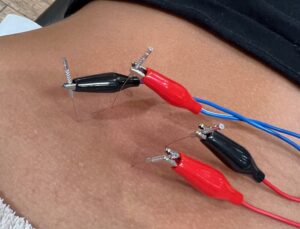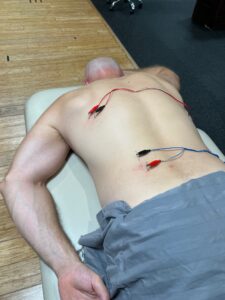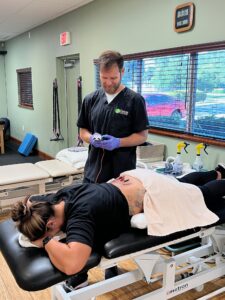
What is dry needling?
Dry needling is a therapeutic treatment that uses thin needles to stimulate trigger points in muscles and connective tissues to treat pain and movement issues. A physical therapist (who goes through multiple courses and close to 100 hours of training) inserts thin needles into trigger points, which are hard knots in muscles that can cause pain and dysfunction.
How does dry needling work?
The needles stimulate the trigger points to release them and allow the muscle to heal. This can improve flexibility and decrease symptoms.
 Benefits of Dry Needling
Benefits of Dry Needling
- Pain Relief: Dry needling for back pain relief, neck pain, and shoulder pain is highly effective. The technique targets deep tissue, providing significant pain reduction.
- Improved Mobility: By releasing muscle tension, dry needling enhances flexibility and range of motion.
- Faster Recovery: Athletes often use this therapy for sports injuries to speed up recovery.
- Enhanced Performance: Regular sessions can help maintain muscle health and prevent injuries.
How it compares to acupuncture
Dry needling is different from acupuncture and is based on western neuroanatomy.
Dry Needling side effects
Side effects are usually minor and include bruising, fatigue, or soreness.

Who SHOULD use this technique?
Athletes: Those looking to enhance performance, prevent injuries, and recover from sports-related injuries can benefit significantly.
Individuals with Chronic Pain: People suffering from conditions like fibromyalgia, chronic back pain, or neck pain can find relief through this therapy.
Post-Surgery Patients: Those recovering from surgeries, such as ACL reconstruction, can use dry needling to reduce pain and improve mobility.
Elderly Individuals: Older adults who experience muscle pain or joint stiffness can benefit from improved flexibility and reduced pain.
People with Neurological Conditions: Individuals with conditions like stroke or multiple sclerosis can improve motor control and reduce muscle spasticity with dry needling.
Who shouldn’t have dry needling?
Some patients shouldn’t have dry needling, including pregnant women, especially during the first trimester, and patients with certain bleeding disorders.
